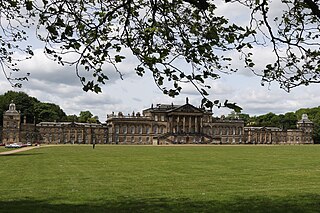
Wentworth Woodhouse is a Grade I listed country house in the village of Wentworth, in the Metropolitan Borough of Rotherham in South Yorkshire, England. It is currently owned by the Wentworth Woodhouse Preservation Trust. The building has more than 300 rooms, with 250,000 square feet (23,000 m2) of floorspace, including 124,600 square feet (11,580 m2) of living area, and was – until it ceased to be privately owned – often listed as the largest private residence in the United Kingdom. It covers an area of more than 2.5 acres (1.0 ha), and is surrounded by a 180-acre (73 ha) park, and an estate of 15,000 acres (6,100 ha).
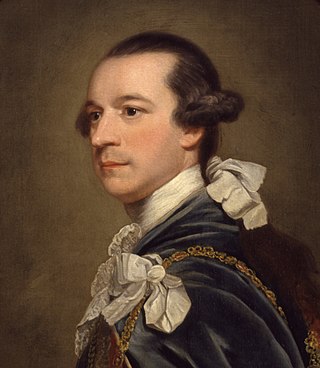
Charles Watson-Wentworth, 2nd Marquess of Rockingham, styled The Honourable Charles Watson-Wentworth before 1739, Viscount Higham between 1739 and 1746, Earl of Malton between 1746 and 1750, and the Marquess of Rockingham from 1750, was a British Whig statesman and magnate, most notable for his two terms as Prime Minister of Great Britain. He became the patron of many Whigs, known as the Rockingham Whigs, and served as a leading Whig grandee. He served in only two high offices during his lifetime but was nonetheless very influential during his one and a half years of service.
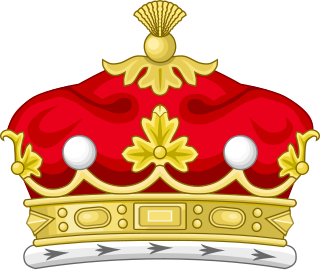
Marquess of Rockingham, in the County of Northampton, was a title in the Peerage of Great Britain. It was created in 1746 for Thomas Watson-Wentworth, 1st Earl of Malton. The Watson family descended from Lewis Watson, Member of Parliament for Lincoln. He was created a Baronet, of Rockingham Castle in the County of Northampton, in the Baronetage of England in 1621. In 1645 he was further honoured when he was raised to the Peerage of England as Baron Rockingham. The third Baron served as Lord-Lieutenant of Kent. In 1714 he was created Baron Throwley, Viscount Sondes and Earl of Rockingham in the Peerage of Great Britain. His eldest son Edward Watson, Viscount Sondes, predeceased him and he was succeeded by his grandson, the second Earl. The second Earl was Lord-Lieutenant of Kent before his early death in 1745. He was childless and was succeeded by his younger brother, Thomas. He had previously represented Canterbury in Parliament.

Elsecar is a village in the Metropolitan Borough of Barnsley in South Yorkshire, England. It is near to Jump and Wentworth, it is also 2 miles (3.2 km) south of Hoyland, 6 miles (9.7 km) south of Barnsley and 8 miles (13 km) north-east of Sheffield. Elsecar falls within the Barnsley Metropolitan Borough Ward of Hoyland Milton.

Earl Fitzwilliam was a title in both the Peerage of Ireland and the Peerage of Great Britain held by the head of the Fitzwilliam family.

Wentworth is a village and civil parish in the Metropolitan Borough of Rotherham in South Yorkshire, England.

Keppel's Column is a 115-foot (35 m) tower Grade II* listed building between Wentworth and Kimberworth in Rotherham, South Yorkshire, England. Keppel's Column is one of several follies in and around Wentworth Woodhouse park; the others include Hoober Stand and Needle's Eye.

Charles William Wentworth Fitzwilliam, 5th Earl Fitzwilliam in the peerage of Ireland, and 3rd Earl Fitzwilliam in the peerage of Great Britain, was a British nobleman and politician. He was president three times of the Royal Statistical Society in 1838–1840, 1847–1849, and 1853–1855; and president of the British Association for the Advancement of Science in its inaugural year (1831–2).
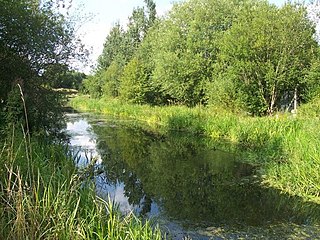
The Greasbrough Canal was a private canal built by the Marquess of Rockingham to serve his coal mining interests in and around the village of Greasbrough, near Rotherham, South Yorkshire, England. It opened in 1780, and the Newbiggin branch was built some time later. The main line to Greasbrough closed in 1840 with the coming of the Sheffield and Rotherham Railway, and the canal ceased to carry commercial traffic during the First World War. Most of it has been filled in, but a small section near the River Don Navigation remains in water.

Great Harrowden is a village and civil parish in North Northamptonshire, with a population at the 2011 census of 161. The village is located near the A509 road running between Kettering and Wellingborough. The village formed part of the Orlingbury hundred and the Borough of Wellingborough. Since 2021 it has been within North Northamptonshire unitary authority.
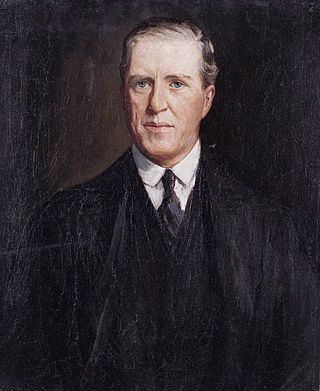
Joseph Watson, 1st Baron Manton was an English industrialist from Leeds, Yorkshire.
Wentworth Castle is a grade-I listed country house, the former seat of the Earls of Strafford, at Stainborough, near Barnsley in South Yorkshire, England. It is now home to the Northern College for Residential and Community Education.
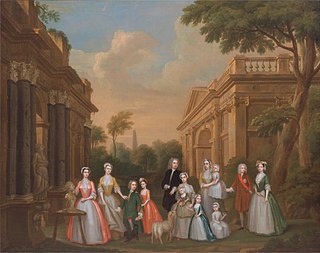
Thomas Watson-Wentworth, 1st Marquess of Rockingham, KB, PC (I) of Wentworth Woodhouse, Yorkshire was a British Whig politician who sat in the House of Commons from 1715 until 1728 when he was raised to the Peerage as Baron Malton.

William Thomas Spencer Wentworth-FitzWilliam, 6th Earl FitzWilliam,, styled Hon. William Wentworth-Fitzwilliam 1815–1835, and Viscount Milton 1835–1857, was a British peer, nobleman, and Liberal Party politician.
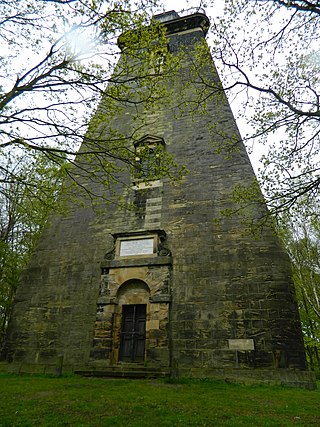
Hoober Stand is a 30-metre-high (98 ft) tower and Grade II* listed building on a ridge in Wentworth, South Yorkshire in northern England. It was designed by Henry Flitcroft for the Whig aristocrat Thomas Watson-Wentworth, Earl of Malton to commemorate the quashing of the 1745 Jacobite rebellion. It lies close to his country seat Wentworth Woodhouse. Its site is approximately 157 metres (515 ft) above sea level and from the top there are long-distance views on a clear day. Hoober Stand is one of several follies in and around Wentworth Woodhouse park; the others include Needle's Eye and Keppel's Column. Sidney Oldall Addy, the Sheffield author calls the structure Woburn Stand in his 1888 book, A glossary of words used in the neighbourhood of Sheffield.

Sheffield Archives collects, preserves and lists records relating to Sheffield and South Yorkshire and makes them available for reference and research.

Milton Hall near Peterborough, is the largest private house in Cambridgeshire, England. As part of the Soke of Peterborough, it was formerly in Northamptonshire. It dates from 1594, being the historical home of the Fitzwilliam family, and is situated in an extensive park in which some original oak trees from an earlier Tudor deer park survive. The house is a Grade I listed building; the garden is Grade II*.
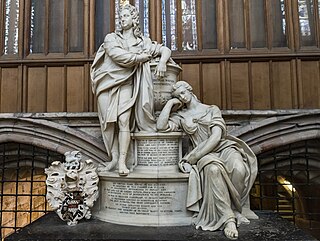
Hon. Thomas Watson, later known as Thomas Watson-Wentworth, of Wentworth Woodhouse in Yorkshire, was an English landowner and politician who sat in the House of Commons between 1701 and 1723.
Wentworth is a civil parish in the Metropolitan Borough of Rotherham, South Yorkshire, England. The parish contains 82 listed buildings that are recorded in the National Heritage List for England. Of these, three are listed at Grade I, the highest of the three grades, eight are at Grade II*, the middle grade, and the others are at Grade II, the lowest grade. The parish includes the village of Wentworth and the surrounding area. The most important building in the parish is Wentworth Woodhouse, a large country house, which is described as "one of England's greatest and most remarkable houses", and is "celebrated for being the longest front of any English country house". The house is listed together with associated structures and items in its grounds. Most of the other listed buildings are houses, cottages, and associated structures, farmhouses and farm buildings. The other listed buildings include churches and items in churchyards, a public house, a former school with attached almshouses, a folly, a mausoleum and a memorial tower, two windmills converted into houses, bridges, a weir and a causeway, a milestone and a milepost, workshops and a forge, a junior school, a former mechanics' institute, a war memorial, and a telephone kiosk.

The Rockingham, or Waterloo, Kiln in Swinton, South Yorkshire, England, is a pottery kiln dating from 1815. It formed part of the production centre for the Rockingham Pottery which, in the early 19th century, produced highly-decorative Rococo porcelain. The pottery failed in the mid-19th century, and the kiln is one of the few remaining elements of the Rockingham manufactory. It is a Grade II* listed building and forms part of the Rockingham Works Scheduled monument. The kiln is currently on the Historic England Heritage at Risk Register.



















